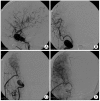Extracranial-intracranial bypass surgery using a radial artery interposition graft for cerebrovascular diseases
- PMID: 22102946
- PMCID: PMC3218175
- DOI: 10.3340/jkns.2011.50.3.185
Extracranial-intracranial bypass surgery using a radial artery interposition graft for cerebrovascular diseases
Abstract
Objective: To investigate the efficacy of extracranial-intracranial (EC-IC) bypass surgery using a radial artery interposition graft (RAIG) for surgical management of cerebrovascular diseases.
Methods: The study involved a retrospective analysis of 13 patients who underwent EC-IC bypass surgery using RAIG at a single neurosurgical institute between 2003 and 2009. The diseases comprised intracranial aneurysm (n=10), carotid artery occlusive disease (n=2), and delayed stenosis in the donor superficial temporal artery (STA) following previous STA-middle cerebral artery bypass surgery (n=1). Patients were followed clinically and radiographically.
Results: Bypass surgery was successful in all patients. At a mean follow-up of 53.4 months, the short-term patency rate was 100%, and the long-term rate was 92.3%. Twelve patients had an excellent clinical outcome of Glasgow Outcome Scale (GOS) 5, and one case had GOS 3. Procedure-related complications were a temporary dysthesia on the graft harvest hand (n=1) and a hematoma at the graft harvest site (n=1), and these were treated successfully with no permanent sequelae. In one case, spasm occurred which was relieved with the introduction of mechanical dilators.
Conclusion: EC-IC bypass using a RAIG appears to be an effective treatment for a variety of cerebrovascular diseases requiring proximal occlusion or trapping of the parent artery.
Keywords: EC-IC arterial bypass; Radial artery interposition graft; Revascularization.
Figures




References
-
- Acar C, Jebara VA, Portoghese M, Beyssen B, Pagny JY, Grare P, et al. Revival of the radial artery for coronary artery bypass grafting. Ann Thorac Surg. 1992;54:652–659. discussion 659-660. - PubMed
-
- Ausman JI, Nicoloff DM, Chou SN. Posterior fossa revascularization : anastomosis of vertebral artery to PICA with interposed radial artery graft. Surg Neurol. 1978;9:281–286. - PubMed
-
- Baaj AA, Agazzi S, van Loveren H. Graft selection in cerebral revascularization. Neurosurg Focus. 2009;26:E18. - PubMed
-
- Boop FA, Story JL, Brown WE, Ansell LV. Cerebral revascularization with an artificial graft : long-term follow-up and discussion of the role of graft pretreatment with modified host endothelial cells. Surg Neurol. 1993;40:155–159. - PubMed
-
- Buxton B, Fuller J, Gaer J, Liu JJ, Mee J, Sinclair R, et al. The radial artery as a bypass graft. Curr Opin Cardiol. 1996;11:591–598. - PubMed
LinkOut - more resources
Full Text Sources

